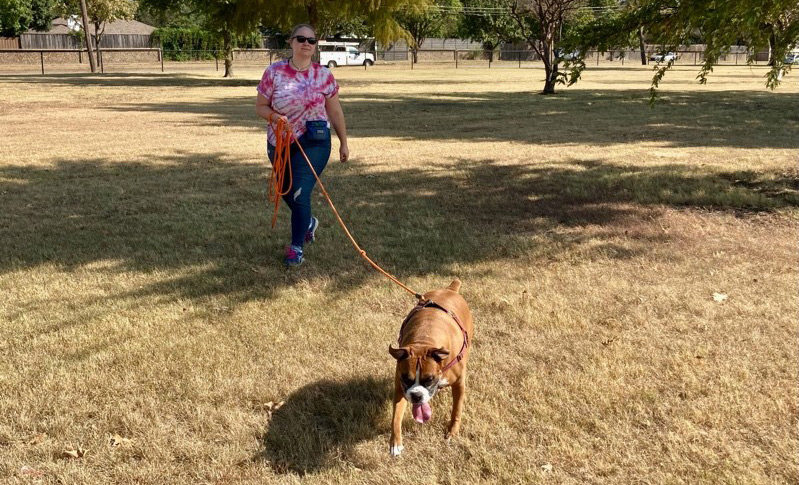The weather in North Texas is finally getting cooler. We’ve had some dry sunny days with temperatures in the low 70s just begging to let the dogs out! But if you’re like most people living in a city or the suburbs, letting your dog off leash just isn’t an option. I love to see the pure joy of a dog running free and have a grand adventure, but your city might have leash laws, or your dog might be reactive to other dogs, or maybe you’re just not so sure he’ll come back. Whatever the case may be, I’m here to tell you that there’s a good alternative.
 When I want to let my dog run & roam, I use a longline. In my case that’s a 30 foot check cord that I’ve modified to make into a useful leash. You can use any long leash you have on hand or wish to buy. After checking the prices on the longer leads on the market, I turned to Snell’s Gundog Supply for a reasonably priced check cord that works like a charm (a check cord is the technical term for a type of long lead used by hunting dogs). If you choose to go this route, I found it helpful to tie a handle in the end because its designed for birddogs to wear when they’re training in the field so it has no loop or handle at the end. I also like to tie a knot or two along it in strategic spots, like 4-6 feet from the dog, 10 feet from the dog, and a foot from the handle. It serves as my own kind of leash brail. The knots closer to the dog help me have better grip strength (don’t ever wrap the lead around your hand if you’re managing a bigger dog because you could damage your hand – regardless of the type or length of leash being used) and the knot before the handle tells me I’m nearing the end. It sounds silly, but you’ll want to be watching your dog much more than the lead, so the knots come in handy.
When I want to let my dog run & roam, I use a longline. In my case that’s a 30 foot check cord that I’ve modified to make into a useful leash. You can use any long leash you have on hand or wish to buy. After checking the prices on the longer leads on the market, I turned to Snell’s Gundog Supply for a reasonably priced check cord that works like a charm (a check cord is the technical term for a type of long lead used by hunting dogs). If you choose to go this route, I found it helpful to tie a handle in the end because its designed for birddogs to wear when they’re training in the field so it has no loop or handle at the end. I also like to tie a knot or two along it in strategic spots, like 4-6 feet from the dog, 10 feet from the dog, and a foot from the handle. It serves as my own kind of leash brail. The knots closer to the dog help me have better grip strength (don’t ever wrap the lead around your hand if you’re managing a bigger dog because you could damage your hand – regardless of the type or length of leash being used) and the knot before the handle tells me I’m nearing the end. It sounds silly, but you’ll want to be watching your dog much more than the lead, so the knots come in handy.
My dog is also leash reactive to other dogs, and rabbits, so I also attach a traffic lead to their harness right next to where the long lead is attached. That super short lead, which is just a handle with a clip, gives me much better control when my 85 pound beast tunes me out completely in order to focus all energy on that other dog or escaping bunny.
Now here’s the important part – no matter what type of long lead you choose to use, never let the lead go completely slack. Always keep the lead coiled in. What’s the point you ask? Isn’t the idea to let your dog run freely & explore? Yes. Yes, it is. But if you don’t manage that lead, your dog is going to knock you on your bottom, or leave you with terrible rope burns. Maybe both. Ask me how I know.
Photo Caption: When Cooper paused for a minute, this is where the lead ended up because of the way it naturally falls down between his front legs. Even if your dog is very good at holding still while you get him untangled, it will require more management if you attach the lead to a collar instead of a harness. With the long lead attached to the back loop on a harness, it will still fall around their feet from time to time, but not nearly as often as with a collar. Of course, if you use the front clip on a harness you’ll run into the same kind of trouble as with a collar.
I’ll tell you. Both times it happened with my own dog – even though I walk dogs professionally & use the long lead whenever I can. Both times happened when I was distracted. I had another person with me, and there was a lot going on at the park we were in. The first time, I was walking my small buffalo on the long lead at a new park. It was going well – until we both saw the ducks in the river at the bottom of a hill. Who knew? He stopped responding to me and just went for it, surprising me completely (we’d seen ducks before). My first instinct was to hold him back. That didn’t work. I didn’t have the traffic lead on him and he was too strong for me to hold him in place using just the long lead. My big mistake was hanging on to the lead. I should’ve let him go. He got to the ducks & plunged in the river, but I was left with severe rope burns on my hands from that lesson!
The other time it happened was when we were in a familiar park, but I was distracted & chatting. I didn’t notice that the rope had wrapped around my leg until he started to trot after something & I didn’t get my leg out in time. Yep, rope burns again. This time it was a nice red stripe on the back of my calf.
These stories help illustrate what NOT to do. Here’s what you should do and what usually works well for me.
Once your long lead is attached to your dog’s harness, let him sniff nearby while you stand on the lead to keep him near you. Starting at the handle, begin making large loops with the extra lead until you’ve gathered up all the slack in one manageable loopy group. Always keep the leash loose, but in control. Let out more lead as he explores /runs a bit further away, and gather it back into large loops as he moves closer. For this reason using the long lead takes both hands, so you can only walk one dog at a time. However, if you have a friend/daughter/sister/buddy who wants to walk another dog along side, that works great too. You’ll just have to keep up with the crisscrossing leads.
A word about harnesses vs collars when using the long lead. A harness will naturally keep the lead up and away from your dog’s paws. Not so important when walking with a regular lead, but while using a long lead, it’s bound to end up on the ground from time to time when you’re reeling in slack. Why is that a problem? Take a look at the picture below.
I have one last story to show how bad things can be if you’re not gathering in your lead and monitoring your dog while out on a long lead with him. We once had a very nice neighbor who would come over to chat if he saw us in the front yard. We’ll call him Fred. One day, Fred came over with his 35 pound dog on a 20 foot lead. Fred didn’t usually work with the dog, but he was that day. While Fred was busy visiting with my husband, his dog spotted a squirrel and ran the entire length of his 20 foot lead in order to catch it. When the little dog reached the end of the line, poor unsuspecting Fred was pulled down with no warning and did an honest to goodness face plant in our front yard! Not only did Fred break his glasses, he broke his neck! The little dog ran off but was quickly recovered, unlike Fred who took months to heal.
So use care when using a long lead with any dog bigger than 15 pounds. It is such a useful tool to help your dog run off some beans (get the wiggles out), but it can cost you dearly if you’re not careful.
Speaking of running off some beans – one of my favorite things to do is to have my dog run around me on the long lead. I’m not much of a runner these days, but he is. Lucky for us we have a “come around” cue (command) that I use in order get him going. I like to run him through his paces by having him circle until I tell him to stop, followed by an immediate down. He’s a very good boy! You might want to play fetch with your dog on the long lead, or some other backyard game. They can swim while you stay on shore. They also love just getting out for a good sniff. Think of the possibilities!
Now get out there and have some fun with your dog!






